Luxembourg Palace and Gardens, in Saint-Germain-des-Prés.
In the 1920s, this Left Bank neighborhood was the heart of Parisian cafe society. You’ll still find plenty of cafes, plus universities and shops, all constantly buzzing with activity. Traditionally arty, intellectual, and bohemian, the area also has a history of political unrest. Today, it is still one of Paris’s most interesting, not to mention picturesque, quarters to explore. START: Métro to St-Michel.
❶ Place Saint-Michel. An elaborate 1860 fountain of Saint Michael presides over this bustling cafe- and shop-lined square, where skirmishes between occupying Germans and French Resistance fighters once took place. This is the beginning of busy Boulevard Saint-Michel, which was trendy long ago but is now a disappointing line of fast-food chains and down-market stores. It is, however, the main student quarters, and a young, lively atmosphere pervades.

The Fontaine Saint-Michel, at the center of Place Saint-Michel.
❷ Rue du Chat-qui-Pêche. Turn left down Rue de la Huchette, bypassing its endless kabob and pizza joints to reach this street, which is one of the narrowest in Paris, at just 1.8m (6 ft.) wide. Plenty of local tales exist about the history of the name (“Street of the Cat Who Fishes”), but nobody knows for sure.
❸ Eglise Saint-Séverin. This charming medieval church was built in the early 13th century and reconstructed in the 15th. Don’t miss the gargoyles projecting from the roof. Inside, linger over the rare Georges Rouault etchings from the early 20th century, and the abstract 1970s stained-glass windows in the apse chapels.  30 min. 1 rue des Pretres St-Séverin, 5th. ☎ 01-42-34-93-50. www.saint-severin.com. Mon–Sat 11am–7:30pm, Sun 9am–8:30pm.
30 min. 1 rue des Pretres St-Séverin, 5th. ☎ 01-42-34-93-50. www.saint-severin.com. Mon–Sat 11am–7:30pm, Sun 9am–8:30pm.
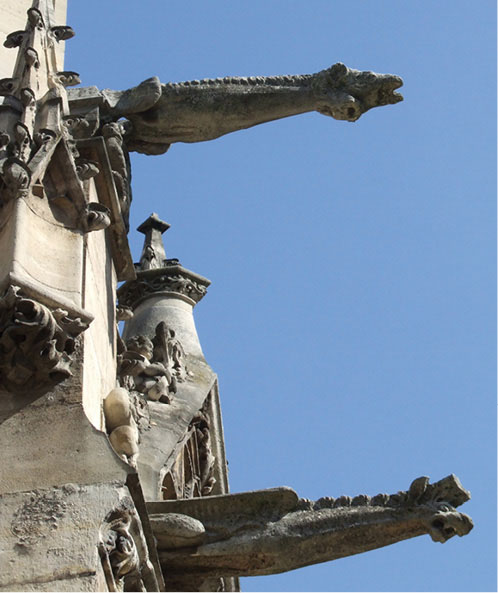
Gargoyles at Eglise Saint-Séverin.
❹ Eglise Saint-Julien-le-Pauvre. Take Rue Saint-Séverin to Rue Galande and, after snapping photos of its quaint old houses, find this Melkite Greek church, which dates, at least in part, to 1170. Note the unusual capitals covered in carved vines and leaves. The garden contains one of the oldest trees in Paris and has one of my favorite views of Notre-Dame.  20 min. Rue St-Julien-le-Pauvre, 5th. ☎ 01-43-54-52-16. www.sjlpmelkites.fr. Mon–Sat 9:30am–noon & 3–6:30pm. Métro: Cluny–La Sorbonne.
20 min. Rue St-Julien-le-Pauvre, 5th. ☎ 01-43-54-52-16. www.sjlpmelkites.fr. Mon–Sat 9:30am–noon & 3–6:30pm. Métro: Cluny–La Sorbonne.
❺ ★★ Musée National du Moyen Age–Thermes de Cluny. With one of the world’s strongest collections of medieval art, this small, manageable museum is a gem. Most visitors come to see the Lady and the Unicorn tapestries, but there’s much more here than long-haired maidens and mythical creatures: This 15th-century Gothic building sits atop 2nd-century baths. The Gallo-Roman pools are in excellent shape—the frigidarium (cold bath) and tepidarium (warm bath) can still be clearly seen (although you can no longer take a dip).  1 hr. 6 place Paul-Painlevé, 5th. ☎ 01-53-73-78-00. www.musee-moyenage.fr. Admission 8€ ages 26 & over, 6€ ages 18–26 from outside E.U., free for ages 25 & under from E.U. countries & 17 & under from outside E.U.; free for everyone 1st Sun of the month. Wed–Mon 9:15am–5:45pm. Métro: Cluny–La Sorbonne.
1 hr. 6 place Paul-Painlevé, 5th. ☎ 01-53-73-78-00. www.musee-moyenage.fr. Admission 8€ ages 26 & over, 6€ ages 18–26 from outside E.U., free for ages 25 & under from E.U. countries & 17 & under from outside E.U.; free for everyone 1st Sun of the month. Wed–Mon 9:15am–5:45pm. Métro: Cluny–La Sorbonne.
❻ ★ La Sorbonne. France’s most famous university, dating back some 700 years, has all the venerable buildings and confident, scraggly-haired students you might imagine. Teachers here have included Thomas Aquinas, and the alumni association counts Dante, Calvin, and Longfellow among its past members. This is a sprawling place, and only the courtyard and galleries are open to the public (9am–5pm) when school is in session—follow the crowds and the scarce signs to get a peek. Or book a guided tour (in French only; Mon–Fri and one Sat per month).  30 min. 12 rue de la Sorbonne, 5th. ☎ 01-40-46-23-48. www.sorbonne.fr. Admission for guided tour adults 9€, students 4€. Métro: Cluny–La Sorbonne.
30 min. 12 rue de la Sorbonne, 5th. ☎ 01-40-46-23-48. www.sorbonne.fr. Admission for guided tour adults 9€, students 4€. Métro: Cluny–La Sorbonne.
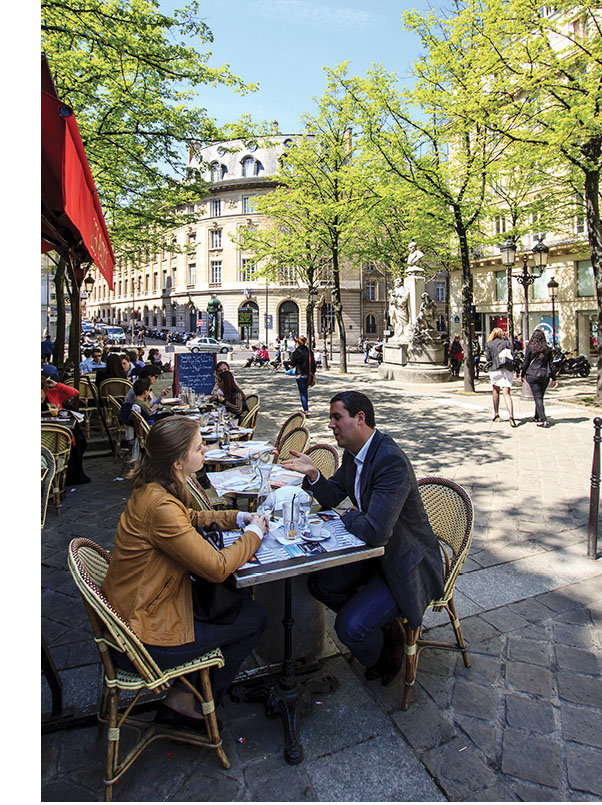
Cafes along Place de la Sorbonne.
❼ ★ Eglise de la Sorbonne. On the grounds of the Sorbonne, this 17th-century church holds the elaborate tomb of Cardinal Richelieu (1585–1642). Richelieu was a staunch defender of the monarchy’s power and did much to unify the French state. The extraordinary statue at its feet is poignantly named Learning in Tears. The figure mourning at the cardinal’s feet represents science, and the one supporting him represents religion.  30 min. Rue de la Sorbonne, 5th.
30 min. Rue de la Sorbonne, 5th.
❽ ★★ Le Panthéon. This magnificent building was built (1764-1790) by Louis XV as a tribute to Saint Geneviève. Since the Revolution, however, it’s been used to honor more earthly heroes. France’s great dead are entombed here, including Voltaire, Rousseau, Zola, and Hugo. Recent additions include Alexandre Dumas (2002) and Marie Curie (in 1995), who was one of only two women here until 2015, when WWII résistantes Geneviève de Gaulle-Anthonioz (de Gaulle’s niece) and Germaine Tillion were accepted. Appropriately, Foucault’s pendulum is here—the famous device, which proved that the Earth rotates on an axis, was said to hang from “the eye of God.” Although the pendulum appears to swing, it’s not moving—the Earth is.  1 hr. Place du Panthéon, 5th. ☎ 01-44-32-18-00; www.pantheon.monuments-nationaux.fr. Admission 7.50€ ages 26 & over, 6€ ages 18–26 from outside E.U., free for ages 25 & under from E.U. countries & 17 & under from outside E.U. Daily 10am–6pm (Apr–Sept until 6:30pm). Métro: Cardinal Lemoine. RER B: Luxembourg.
1 hr. Place du Panthéon, 5th. ☎ 01-44-32-18-00; www.pantheon.monuments-nationaux.fr. Admission 7.50€ ages 26 & over, 6€ ages 18–26 from outside E.U., free for ages 25 & under from E.U. countries & 17 & under from outside E.U. Daily 10am–6pm (Apr–Sept until 6:30pm). Métro: Cardinal Lemoine. RER B: Luxembourg.
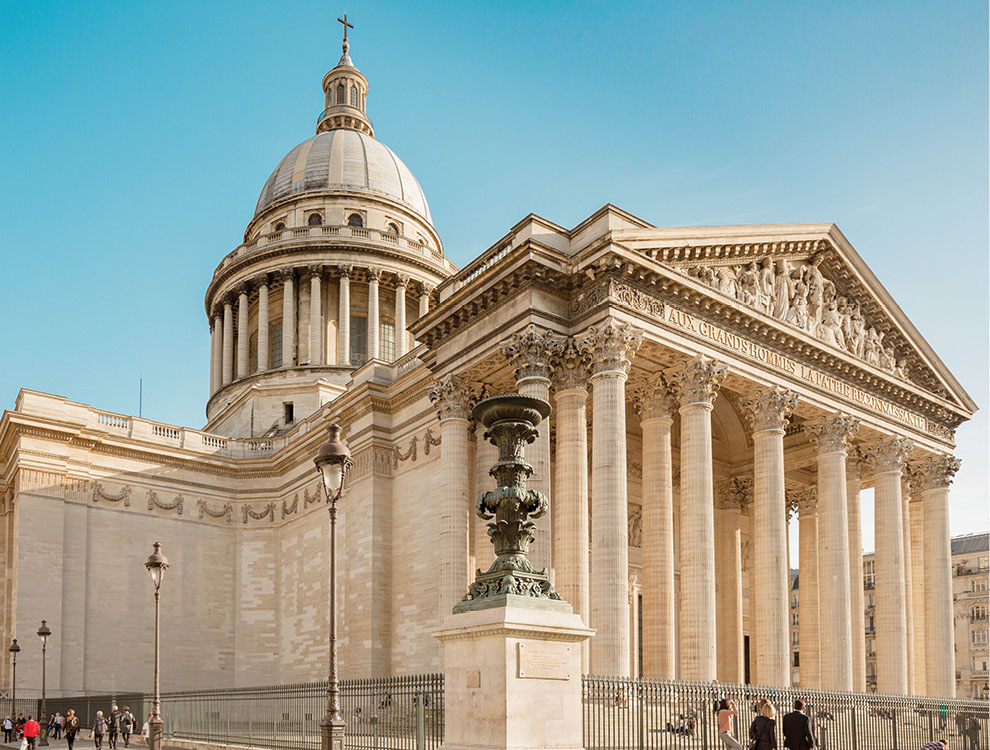
Le Panthéon, an 18th-century memorial hall honoring France’s greatest intellectuals.
 Les Papilles. Dying for a break? This is just the place. The owners of this sweet Provençal-style bistro are dedicated to Southern French food and adventurous wine. The small menu changes with the seasons, and the wines change with the owners’ moods. If it’s available, try the excellent stewed chicken or the hearty cassoulet. 30 rue Gay-Lussac, 5th. ☎ 01-43-25-20-79. www.lespapillesparis.fr. RER B: Luxembourg. $$.
Les Papilles. Dying for a break? This is just the place. The owners of this sweet Provençal-style bistro are dedicated to Southern French food and adventurous wine. The small menu changes with the seasons, and the wines change with the owners’ moods. If it’s available, try the excellent stewed chicken or the hearty cassoulet. 30 rue Gay-Lussac, 5th. ☎ 01-43-25-20-79. www.lespapillesparis.fr. RER B: Luxembourg. $$.
This neighborhood was the place to be in the 1920s. Here the literati met the glitterati and tout Paris marveled at the ensuing explosion of creativity and alcoholism. On these streets, Sartre fumed while Hemingway and Fitzgerald drank and quarreled. Today the bookshops have been replaced by designer boutiques, but it’s still the place to go for a night on the town. START: Métro to Luxembourg.
❶ ★★★  Jardins & Palais du Luxembourg. There’s a certain justice in the fact that this former palace, built between 1615 and 1627 for the widow of Henry IV, is now home to the democratically elected French Senate. The lovely Italianate building also houses the Musée du Luxembourg, famed for its world-class temporary art exhibitions (19 rue de Vaugirard, 6th; ☎ 01-40-13-62-00; www.museeduluxembourg.fr). Most people, however, come for the gardens. Hemingway claimed to have survived a winter by catching pigeons here for his supper, and Gertrude Stein used to cross the gardens on her way to sit for Picasso. The classic formal gardens are well groomed and symmetrically designed. And there are statues everywhere—more than 80 of them vie for your attention—a long-haired French queen, a nymph playing a flute, a stern effigy of poet Charles Baudelaire. It’s fanciful and delightful; you could spend hours here and not discover all its secrets. Particularly popular with families are the pond in which children float wooden boats, the games area, and pétanque (French boules) pitches.
Jardins & Palais du Luxembourg. There’s a certain justice in the fact that this former palace, built between 1615 and 1627 for the widow of Henry IV, is now home to the democratically elected French Senate. The lovely Italianate building also houses the Musée du Luxembourg, famed for its world-class temporary art exhibitions (19 rue de Vaugirard, 6th; ☎ 01-40-13-62-00; www.museeduluxembourg.fr). Most people, however, come for the gardens. Hemingway claimed to have survived a winter by catching pigeons here for his supper, and Gertrude Stein used to cross the gardens on her way to sit for Picasso. The classic formal gardens are well groomed and symmetrically designed. And there are statues everywhere—more than 80 of them vie for your attention—a long-haired French queen, a nymph playing a flute, a stern effigy of poet Charles Baudelaire. It’s fanciful and delightful; you could spend hours here and not discover all its secrets. Particularly popular with families are the pond in which children float wooden boats, the games area, and pétanque (French boules) pitches.  1 hr. Métro: Odéon. RER: Luxembourg.
1 hr. Métro: Odéon. RER: Luxembourg.

Palais du Luxembourg, home to the French Senate.
❷ Place & Rue Saint-Sulpice. Turn down any street on the river side of the gardens and walk a few blocks to Place Saint-Sulpice and its surrounding streets. Welcome to shopping heaven (or window-shopping purgatory). This is where you’ll find all the usual designer suspects for your inspection—agnès b., YSL, perfumer Annick Goutal, and more. If you want to stock up for a picnic, pop down to 8 rue du Cherche-Midi to Poilâne bakery for some of the city’s best breads and sandwiches to go. Or turn onto Rue Bonaparte, where Pierre Hermé (at no. 72) makes the city’s most delicious macaroons.
❸ ★★ Eglise Saint-Sulpice. Filled with paintings by Delacroix, including Jacob’s Fight with the Angel, this is a wonderful church in which to meditate and take in some gorgeous frescoes. The church has one of the world’s largest organs, comprising 6,700 pipes—a national treasure, especially when it’s played (see www.stsulpice.com for a schedule).  30 min. Rue St-Sulpice, 6th. ☎ 01-42-34-59-98. www.pss75.fr/saint-sulpice-paris. Daily 7:30am–7:30pm.
30 min. Rue St-Sulpice, 6th. ☎ 01-42-34-59-98. www.pss75.fr/saint-sulpice-paris. Daily 7:30am–7:30pm.
 La Méditérranée. A short walk away lies this restaurant, filled with murals by 20th-century stage designers Christian Bérard and Marcel Vertés and paintings by Picasso and Chagall. It was once a haunt of Jacqueline Kennedy, Picasso, and Jean Cocteau (whose work enlivens the plates and menus). The chef delivers creative interpretations of traditional dishes, including an incredible bouillabaisse, thick with seafood. 2 place de l’Odéon, 6th. ☎ 01-43-26-02-30. www.la-mediterranee.com. Métro: Odéon. $$$.
La Méditérranée. A short walk away lies this restaurant, filled with murals by 20th-century stage designers Christian Bérard and Marcel Vertés and paintings by Picasso and Chagall. It was once a haunt of Jacqueline Kennedy, Picasso, and Jean Cocteau (whose work enlivens the plates and menus). The chef delivers creative interpretations of traditional dishes, including an incredible bouillabaisse, thick with seafood. 2 place de l’Odéon, 6th. ☎ 01-43-26-02-30. www.la-mediterranee.com. Métro: Odéon. $$$.

The mighty pipe organ at Eglise Saint-Sulpice.
❺ Rue de l’Abbaye. Saint-Germain was built around an old abbey that once towered over this street, although there’s virtually nothing left of it today. With houses and churches built from brick, the street is charming, particularly Rue de Furstenberg—once the abbot’s stables, it’s now filled with upscale design shops and galleries.
❻ ★ Musée National Eugène Delacroix. The Romantic painter Eugène Delacroix lived and worked in this lovely house on Rue de Furstenberg from 1857 until his death in 1863. The museum sits on a charming square and has a romantic garden. Most of his major works are in the Louvre (you may buy a joint ticket for the Louvre, 15€), but the collection here is unusually personal, including an early self-portrait and letters and notes to such friends as Baudelaire and George Sand. You can also see his work in the Chapelle des Anges in Eglise Saint-Sulpice (see stop ❸ on this tour).  1 hr. 6 rue de Furstenberg, 6th. ☎ 01-44-41-86-50. www.musee-delacroix.fr. Admission 7€ adults, free for children 17 & under & visitors 25 & under from E.U. countries. Wed–Mon 9:30am–5:30pm. Métro: St-Germain-des-Prés.
1 hr. 6 rue de Furstenberg, 6th. ☎ 01-44-41-86-50. www.musee-delacroix.fr. Admission 7€ adults, free for children 17 & under & visitors 25 & under from E.U. countries. Wed–Mon 9:30am–5:30pm. Métro: St-Germain-des-Prés.
❼ ★ Eglise Saint-Germain-des-Prés. This exquisite little church is the oldest in Paris. It dates to the 6th century, when a Benedictine abbey was founded here by Merovingian king Childebert, although little remains from that time. Its aged columns still bear their medieval paint in breathtaking detail. You can visit the tomb of the French philosopher René Descartes (1596–1650) in the second chapel. On the right as you enter, look into the Chapelle de Saint-Symphorien. It was here, during the revolution, that many clergymen were imprisoned before being executed just outside on the square.  30 min. 3 place St-Germain-des-Prés, 6th. ☎ 01-55-42-81-10. www.eglise-sgp.org. Mon–Sat 8am–7:45pm, Sun 9am–8pm. Métro: St-Germain-des-Prés.
30 min. 3 place St-Germain-des-Prés, 6th. ☎ 01-55-42-81-10. www.eglise-sgp.org. Mon–Sat 8am–7:45pm, Sun 9am–8pm. Métro: St-Germain-des-Prés.
❽ Rue Jacob. This elegant street, with clean lines and classic 19th-century architecture, was once home to such illustrious residents as the author Colette and the composer Richard Wagner. Today, it holds charming bookstores and antiques shops and is all very posh-bohemian.
❾ Ecole Nationale Supérieure des Beaux-Arts. Turn onto Rue Bonaparte and walk toward the river to reach this fine-arts school, where the main attraction is the architecture. The school occupies a 17th-century convent and the 18th-century Hôtel de Chimay. Attending an exhibition (held frequently) will grant you a peek inside, but if none is on, just wander down Rue Bonaparte, which is lined with lovely small art galleries.  30 min. 14 rue Bonaparte, 6th. ☎ 01-47-03-50-00. www.ensba.fr. Courtyard Mon–Fri 9am–5pm; during exhibitions Tues–Sun 1–7pm. Métro: St-Germain-des-Prés.
30 min. 14 rue Bonaparte, 6th. ☎ 01-47-03-50-00. www.ensba.fr. Courtyard Mon–Fri 9am–5pm; during exhibitions Tues–Sun 1–7pm. Métro: St-Germain-des-Prés.
❿ L’Institut de France. Turn right along the river and you’ll see an elegant domed baroque building, home to five subgovernmental agencies all lumped together as the rather ominously named L’Institut. Here the Académie Française zealously guards the purity of the French language from “Franglais” encroachment, while other, lesser-known agencies (Sciences, Inscriptions et Belles Lettres, Beaux Arts, and Sciences Morales et Politiques) do . . . whatever it is they do. It’s all a bit intimidating (academy members are known as “the Immortals”), and all buildings are closed to the public, but it’s possible to arrange in advance for a guided tour (available in English).  15 min. 23 quai de Conti, 6th. ☎ 01-44-41-44-41. www.institut-de-france.fr. Guided tours 2nd Sun of the month (request via website only). Métro: St-Germain-des-Prés or Louvre Rivoli.
15 min. 23 quai de Conti, 6th. ☎ 01-44-41-44-41. www.institut-de-france.fr. Guided tours 2nd Sun of the month (request via website only). Métro: St-Germain-des-Prés or Louvre Rivoli.
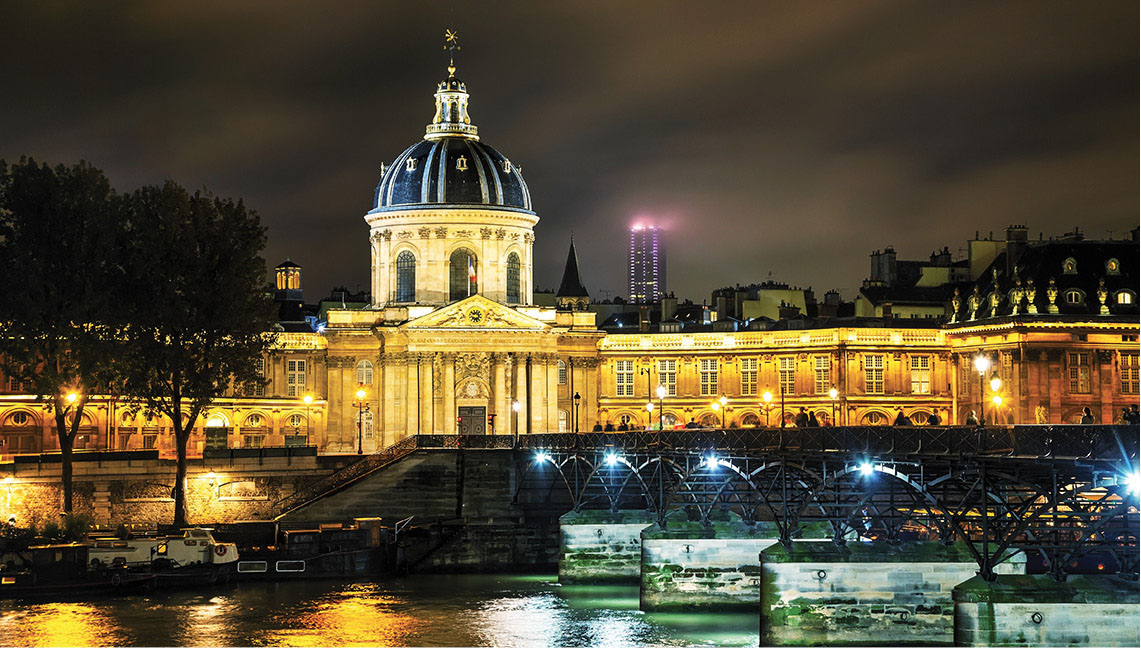
The imposing Institut de France houses several government agencies.
The Île de la Cité is where it all began. By the time the Romans came in 52 b.c., the Celtic Parisii tribe had been living on the Île de la Cité for about 200 years. Over the next 2 millennia, Paris was expanded by the Romans, Franks, Merovingians, and Capetian kings, but the city’s soul remains here, around Notre-Dame cathedral. Across the pont Saint-Louis, Île Saint-Louis (former marshlands) is a coveted residential area filled with glorious 17th-century mansions. This tour takes you through both islands and along some of the loveliest stretches of the Seine. START: Métro to Cité.
❶ Île de la Cité. By medieval times, this was a thriving island town with huddles of houses and narrow streets. But it was all swept away in the 19th century by Baron Haussmann when he evicted some 25,000 people to make way for the large administrative buildings we see today, such as the law courts. Few have written more movingly about its heyday than Victor Hugo, who invites the reader “to observe the fantastic display of lights against the darkness of that gloomy labyrinth of buildings; cast upon it a ray of moonlight, showing the city in glimmering vagueness, with its towers lifting their great heads from that foggy sea.” You have only to climb Notre-Dame’s towers to see what he’s talking about: On a cloudy day, dramatic skies cast eerie light over the island. Linking the Île de la Cité to the city at large is the pont Neuf, embellished by a statue of Henri IV. The name means “new bridge”—ironic considering that it’s Paris’s oldest bridge, dating back to the 16th century. A staircase below leads to the Square du Vert-Galant, my favorite riverside picnic spot.

Pont Neuf, at the western end of Île de la Cité.
❷ ★ La Conciergerie. This intimidating building, originally a medieval royal palace, was converted into a prison during the Revolution and became an object of terror at a time when idle accusations could result in spontaneous executions. Marie Antoinette, Danton, and Robespierre all were held here before being guillotined. Today, you can see the cells where they were held and the rooms where they were tried and condemned. A strange and interesting place. See p 9, ❸.
❸ ★ Sainte-Chapelle. Tucked away among the huge Conciergerie and the vast law courts of the Palais de Justice is this tiny church—a precious place seemingly made almost entirely of dazzling stained-glass windows. One of the loveliest things you can do is visit at night for a classical music concert. You’ll find a list of concerts on the website. See p 23, ❸.
❹ Marché aux Fleurs Reine-Elizabeth-II. Recently renamed after Queen Elizabeth II, to commemorate the 70th anniversary of the Normandy landings in WWII, this vivid flower market must be one of the most photographed places in the city—and for good reason. On Sunday, it’s transformed into a bird market, but the standard of living for the animals presented is questionable.  30 min. Place Louis Lépine, Quai de la Corse, Quai des Fleurs, 4th. Mon–Sat 8am–7:30pm, Sun 8am–7pm. Métro: Cité.
30 min. Place Louis Lépine, Quai de la Corse, Quai des Fleurs, 4th. Mon–Sat 8am–7:30pm, Sun 8am–7pm. Métro: Cité.
❺ ★★★ Cathédrale Notre-Dame. This world-famous cathedral is more beautiful in person than on film. Climb its towers to see snarling gargoyles and sweeping panoramas of the city. See p 9, ❼.

Climb Notre-Dame’s tower and you’ll be rewarded with close-ups of gargoyles and sweeping city views.
❻ Île Saint-Louis. Despite its central location, the Île Saint-Louis still feels like a tranquil backwater, removed, somehow, from the rest of the buzzing city. The 17th-century buildings lining the narrow streets are some of the city’s most expensive properties, and many of them have hosted, at one point or another, French literary stars, such as Racine and Molière. A bourgeois arty crowd still frequents the many art galleries around. It’s a lovely place to wander, and so tiny that it’s almost impossible to get lost.
❼ Rue Saint-Louis-en-l’Île. The Île Saint-Louis’s central artery is gorgeous, narrow, and lined with restaurants and boutiques selling art, clothes, precious stones and minerals, food, hats, and jewelry. Hôtel Chenizot, at no. 51, has fantastic carved dragons and bearded fauns on its facade. Go through the door and admire the sculpted facade in the courtyard beyond. A second courtyard also contains craft shops and galleries. The end of the street closest to the Île de la Cité is a great place to get a photo of Notre-Dame.
 Berthillon. On Île Saint-Louis, even the ice-cream stores are sophisticated. This place proves it, with polite crowds queuing outside for cones to go, and others perched at the tables inside to try the lemon, hazelnut, and mango flavors favored by the locals—the chocolate is especially divine. 31 rue St-Louis-en-l’Île, 4th, www.berthillon.fr. Métro: Pont Marie. $.
Berthillon. On Île Saint-Louis, even the ice-cream stores are sophisticated. This place proves it, with polite crowds queuing outside for cones to go, and others perched at the tables inside to try the lemon, hazelnut, and mango flavors favored by the locals—the chocolate is especially divine. 31 rue St-Louis-en-l’Île, 4th, www.berthillon.fr. Métro: Pont Marie. $.
❾ Eglise Saint-Louis-en-l’Île. This 17th-century church, vastly overshadowed by Notre-Dame, has wonderful rococo-baroque architecture, including a lovely sunburst above the altar. Not as dramatic as its famous neighbor, but it’s more intimate and enchanting.  20 min. 19 rue St-Louis-en-l’Île, 4th. ☎ 01-46-34-11-60. www.saintlouisenlile.catholique.fr. Tues–Sun 10am–1pm & 3–7:30pm. Métro: Pont Marie.
20 min. 19 rue St-Louis-en-l’Île, 4th. ☎ 01-46-34-11-60. www.saintlouisenlile.catholique.fr. Tues–Sun 10am–1pm & 3–7:30pm. Métro: Pont Marie.
❿ ★★ Hôtel Lauzun. This astonishing place, with fantastic drains in the shapes of sea serpents, was where poets Baudelaire and Théophile Gautierthe hosted famously long, hazy hashish parties. Baudelaire wrote Les Fleurs du Mal while living here, although it’s hard to see how he could have been so depressed living somewhere so pretty. The building takes its name from a former occupant, the duc de Lauzun. He was a favorite of Louis XIV until he asked for the hand of the king’s cousin, the Duchesse de Montpensier. Louis refused and had Lauzun tossed into the Bastille. Eventually the duchesse convinced Louis to release him, and they married secretly and moved here in 1682. 17 quai d’Anjou. Generally closed to the public, although guided tours are becoming more frequent. Check with the tourist office or try www.guideapolis.fr (French-only tours). Métro: Pont Marie.
When the Île de la Cité became overcrowded in the 17th century, it was here, to what had been swampland, that the wealthy Parisians moved, filling the streets with fashionable mansions called hôtels. Over the years, it became the center of the city’s Jewish community, although today the gay and lesbian community has also adopted the area. Its many boutiques and diverse buildings make for excellent shopping and exploring. START: Métro to St-Paul.
❶ Hôtel de Béthune-Sully. Out of the Métro, turn right on Rue Saint-Antoine and walk through the wooden doorway at no. 62. The relief-studded facade of this gracious mansion dazzles just as much as when it was first designed as the residence of the family of Maximilien de Béthune, duke of Sully, Henri IV’s famous minister, in 1625. It stands as one of the finest Louis XIII structures in Paris and, although the building is closed to the public, the charming walled garden is open during office hours (and on weekends from around 9am–6pm). A “secret” door leads to the Place des Vosges (see ❽, below).  30 min. 62 rue St-Antoine, 4th. www.sully.monuments-nationaux.fr. Métro: St-Paul.
30 min. 62 rue St-Antoine, 4th. www.sully.monuments-nationaux.fr. Métro: St-Paul.

The Hôtel de Béthune-Sully is one of the finest 17th-century buildings in Paris.
❷ Hôtel de Sens. Given the leaded windows and fairy-tale turrets, you might not be surprised to find that this 15th-century mansion has a gloriously ornate courtyard in which you can wander at will most afternoons. Once a private home for archbishops and, later, queens, it now holds a fine-arts library, the Bibliothèque Forney.  20 min. 1 rue du Figurier. ☎ 01-42-78-14-60. Courtyard Mon–Fri 8am–8:30pm, Sat–Sun 9am–8:30pm (until 7:30pm Sept–Apr). Métro: St-Paul.
20 min. 1 rue du Figurier. ☎ 01-42-78-14-60. Courtyard Mon–Fri 8am–8:30pm, Sat–Sun 9am–8:30pm (until 7:30pm Sept–Apr). Métro: St-Paul.
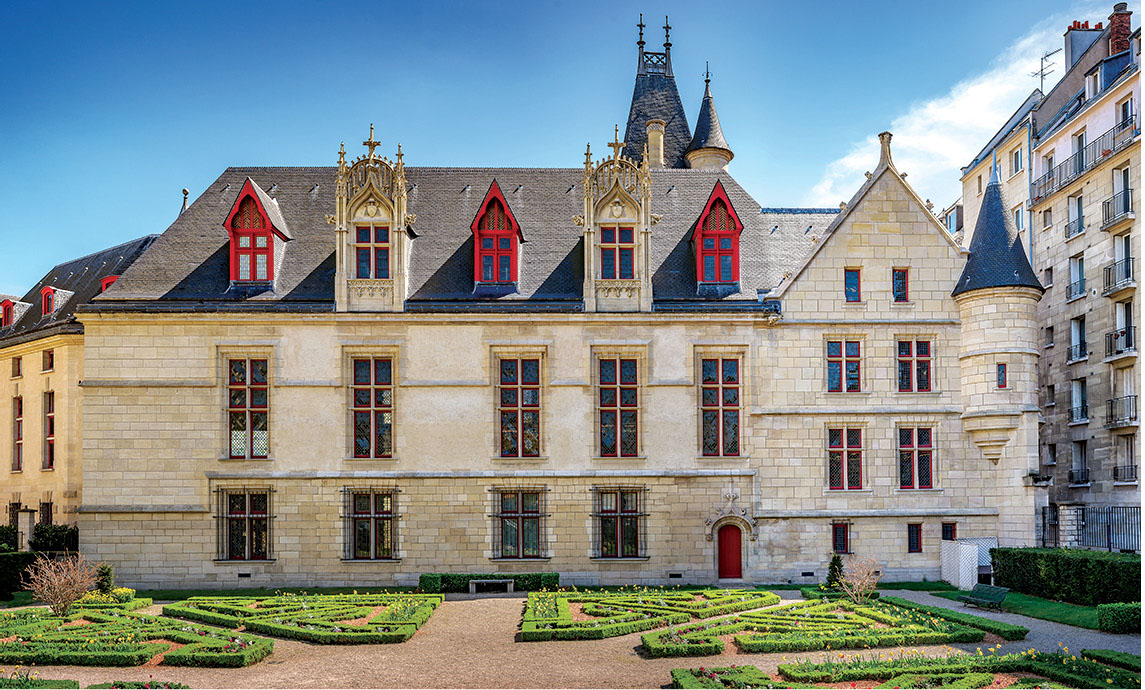
The Hôtel de Sens once housed the archbishops of Sens.
❸ Rue des Rosiers. Perhaps the most colorful and typical street remaining from the time when this was the city’s Jewish quarter, Rue des Rosiers (Street of the Rosebushes) meanders among the old buildings with nary a rose to be seen. It is jam-packed with falafel cafes and shops, though, and makes a plum spot for a cheap lunch.
 ★ Le Loir dans la Théière. This bustling cafe serves some of the best salads and homemade cakes in the Marais. There’s usually a queue to get a table, but it’s worth the wait—especially for the humongous lemon meringue pies (7.50€ a slice). 3 rue des Rosiers, 4th. ☎ 01-42-72-90-61. $.
★ Le Loir dans la Théière. This bustling cafe serves some of the best salads and homemade cakes in the Marais. There’s usually a queue to get a table, but it’s worth the wait—especially for the humongous lemon meringue pies (7.50€ a slice). 3 rue des Rosiers, 4th. ☎ 01-42-72-90-61. $.
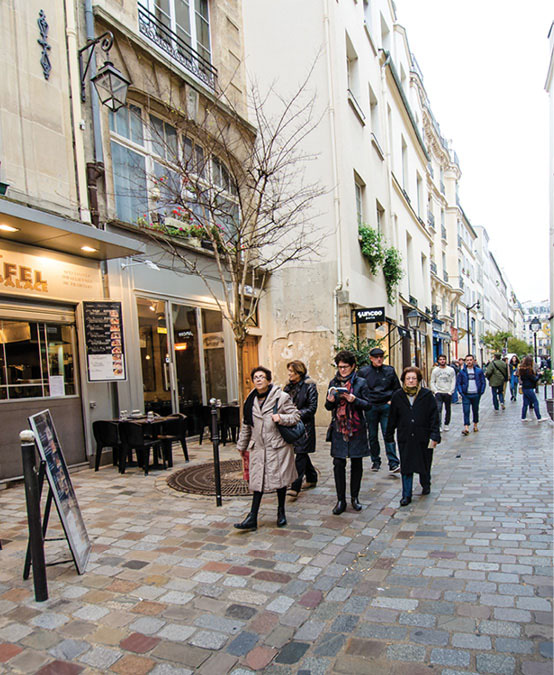
Strolling along colorful Rue des Rosiers.
❺ ★ Musée d’Art et d’Histoire du Judaïsme. This museum was created in 1948 to protect the city’s Jewish history after the Holocaust. It’s a moving place, with excellent Jewish decorative arts from around Europe—German Hanukkah lamps, a wooden sukkah cabin from Austria—and documents related to the continent’s Jewish history. There’s also a memorial to the Jews who lived in the building in 1939, 13 of whom died in concentration camps.  45 min. Hôtel de St-Aignan, 71 rue du Temple, 3rd. ☎ 01-53-01-86-60. www.mahj.org. Mon–Fri 11am–6pm, Sun 10am–6pm. Admission 8€ ages 26 & up, 4.50€ ages 18 to 25, free for ages 18 & under. Métro: Rambuteau.
45 min. Hôtel de St-Aignan, 71 rue du Temple, 3rd. ☎ 01-53-01-86-60. www.mahj.org. Mon–Fri 11am–6pm, Sun 10am–6pm. Admission 8€ ages 26 & up, 4.50€ ages 18 to 25, free for ages 18 & under. Métro: Rambuteau.
❻ ★★ Musée National Picasso. This fabulous museum’s permanent collection boasts some 5,000 works by Pablo Picasso (though not all are on show at once). Pieces from his Blue period, Surrealist paintings and Cubist sculptures sit alongside startling assemblages of Picasso’s own art collection, with works by Modigliani and Renoir. A showpiece in its own right is the building—the Hôtel Salé—one of the most extravagant 17th-century mansions in Paris, built by salt-tax farmer and advisor to Louis XIV Pierre Aubert (hence the building’s name: “salé” means “salty”). The magnificent central staircase was based on Michelangelo’s stair plan for the Laurentian Library in Florence.  1 hr. Hôtel Salé, 5 rue du Thorigny, 3rd. ☎ 01-85-56-00-36. www.museepicassoparis.fr. Tues–Sun 9:30am–6pm. Admission 13€ ages 27 & up, free for ages 18 and under & visitors 25 & under from E.U. countries. Métro: Saint-Paul.
1 hr. Hôtel Salé, 5 rue du Thorigny, 3rd. ☎ 01-85-56-00-36. www.museepicassoparis.fr. Tues–Sun 9:30am–6pm. Admission 13€ ages 27 & up, free for ages 18 and under & visitors 25 & under from E.U. countries. Métro: Saint-Paul.
❼ Musée Carnavalet. The Renaissance palace that houses this free museum was acquired by Mme de Carnavalet (hence its name), but is most associated with the letter-writing Mme de Sévigné, who moved here in 1677 to be with her daughter and poured out nearly every detail of her life in her letters. Several salons cover the Revolution, and others display furniture from the Louis XIV period to the early 20th century, including a replica of Marcel Proust’s cork-lined bedroom. Also on view are the chessmen Louis XVI used to distract himself while waiting to go to the guillotine.  1 hr. 16 rue des Francs-Bourgeois, 3rd. ☎ 01-44-59-58-58. www.carnavalet.paris.fr. Tues–Sun 10am–6pm. Free admission. Métro: St-Paul or Chemin Vert.
1 hr. 16 rue des Francs-Bourgeois, 3rd. ☎ 01-44-59-58-58. www.carnavalet.paris.fr. Tues–Sun 10am–6pm. Free admission. Métro: St-Paul or Chemin Vert.
❽ Place des Vosges. This is Paris’s oldest square and was once its most fashionable; today it’s arguably its most adorable, with perfect brick-and-stone pavilions rising above covered arcades. Its perfect symmetry might be why so many writers and artists (Descartes, Pascal, Gautier, and Hugo) chose to live here. See p 14, ❺.

Lounging on the lawns of the Place des Vosges.
❾ Maison de Victor Hugo. The writer of Les Misérables lived here from 1832 to 1848, and his home has been turned into a tiny shrine, with period rooms dedicated to his life and works. Room 3 is particularly impressive, with an Oriental-style medley of black, green, and red panels and porcelain. The decor is based on the Chinese room at Hauteville Fairy in Guernsey, where Hugo’s mistress, Juliette Drouet, lived during the couple’s exile from France (after Napoleon III’s coup d’état). The views from the windows offer an interesting panorama over the pink-brick Place des Vosges.  30 min. 6 place des Vosges, 4th. ☎ 01-42-72-10-16, www.maisonsvictorhugo.paris.fr. Free admission. Tues–Sun 10am–6pm. Métro: St-Paul or Bastille.
30 min. 6 place des Vosges, 4th. ☎ 01-42-72-10-16, www.maisonsvictorhugo.paris.fr. Free admission. Tues–Sun 10am–6pm. Métro: St-Paul or Bastille.
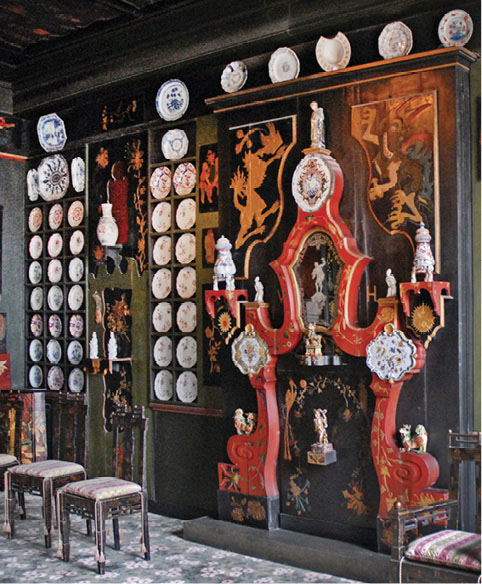
Striking Chinese-inspired decor in the Maison de Victor Hugo.
Artsy, graceful, undulating Montmartre does something to your heart. From the moment you see its narrow, tilting houses, still windmills, and steep streets, you’re in love. This part of town—known as the La Butte, or “the Hill” in the 18th arrondissement—was a rural village separate from Paris until 1860. Then, in the 1880s, Renoir and Toulouse-Lautrec helped make it a lair of artists—a legacy that lives on today. It all starts at the Abbesses Métro station—designed by French architect Hector Guimard, it’s one of only two stations in Paris that still has its original Art Nouveau roof (the other is Porte Dauphine, in the 16th). START: Métro to Abbesses.
❶ Bateau-Lavoir. This building is called the “cradle of Cubism.” While living here from 1904 to 1912, Picasso painted The Third Rose (of Gertrude Stein) and Les Demoiselles d’Avignon. Today, it’s filled with art studios, with some occasionally open to view.  10 min. 13 place Emile Goudeau. Métro: Abbesses.
10 min. 13 place Emile Goudeau. Métro: Abbesses.
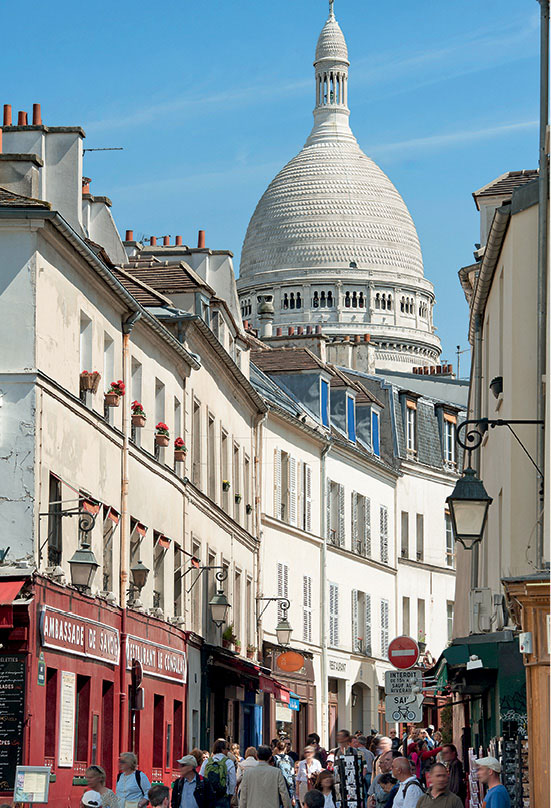
Winding streets lead up to the Sacré Coeur.
❷ Rue des Abbesses. On this street, the unusual rust-red church with the turquoise mosaics is the neo-Gothic Saint-Jean-de-Montmartre, built early in the 20th century. Peek inside to see its delicately weaving arches. Many excellent cafes and dress shops line this street.
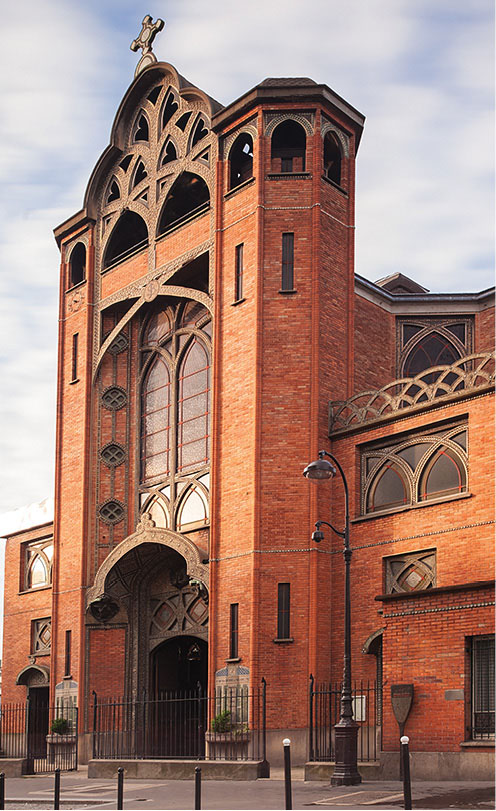
The Saint-Jean-de-Montmartre church.
❸ Rue Tholoze. Rue des Abbesses soon brings you to this steep, narrow street, with an adorable windmill at the top. Halfway up is Studio 28, which was the city’s first proper art-house cinema, named after the year it opened. It showed Buñuel’s L’Age d’Or in 1930, and outraged locals ripped the screen from the wall. Today, it still shows arty flicks and has a tiny bar.
This moulin (windmill), atop Rue Tholoze, is the subject of a recently authenticated van Gogh painting.
 Moulin Radet & Moulin de la Galette. The Moulin Radet windmill, confusingly enough, tops a restaurant called Le Moulin de la Galette, after the dance hall that once stood here, inspiring such artists as Renoir. The food here is traditionally French and moderately priced. 83 rue Lepic. ☎ 01-46-06-84-77. www.lemoulindelagalette.fr. $$.
Moulin Radet & Moulin de la Galette. The Moulin Radet windmill, confusingly enough, tops a restaurant called Le Moulin de la Galette, after the dance hall that once stood here, inspiring such artists as Renoir. The food here is traditionally French and moderately priced. 83 rue Lepic. ☎ 01-46-06-84-77. www.lemoulindelagalette.fr. $$.
❺ Place du Tertre. This old square would be lovely were it not for the tourists—and the artists chasing you around, threatening to draw your caricature. You can buy some very good original paintings here, but you’ll have to haggle to get a reasonable price. The perpetual hubbub can be entertaining—it’s charming and awful all at once.
❻ Musée de Montmartre & Jardins Renoir. This oasis of calm will give you a good look at Montmartre’s artistic history. There are pictures of 19th-century Montmartre, rural and lined with windmills, along with a few Toulouse-Lautrec posters and the like. The gardens—named after Auguste Renoir, who lived on-site from 1875 to 1877—offer heartwarming cityscapes and views over Montmartre’s vineyard (see ❾).  45 min. 12 rue Cortot, 8th. ☎ 01-49-25-89-37. www.museedemontmartre.fr. Admission 9.50€ ages 26 & over, 7.50€ ages 18–25, 5.50€ ages 10–17, free for children 10 & under. Daily 10am–6pm. Métro: Abbesses or Lamarck-Caulincourt.
45 min. 12 rue Cortot, 8th. ☎ 01-49-25-89-37. www.museedemontmartre.fr. Admission 9.50€ ages 26 & over, 7.50€ ages 18–25, 5.50€ ages 10–17, free for children 10 & under. Daily 10am–6pm. Métro: Abbesses or Lamarck-Caulincourt.
❼ Saint-Pierre-de-Montmartre. Follow the winding roads ever upward to this early-Gothic Benedictine abbey, now a small church. This is one of the city’s oldest churches (from 1133), and its simplicity in the shadow of the Sacré Coeur is refreshing.  15 min. Rue du Mont-Cenis.
15 min. Rue du Mont-Cenis.
❽ ★★ Sacré Coeur. The creamy white domes of this basilica soar high above Paris. Inside is an artistic and architectural explosion of color and form; out front are sweeping views of the gorgeous city in soft pastels. Unmissable. See p 17, ❷.
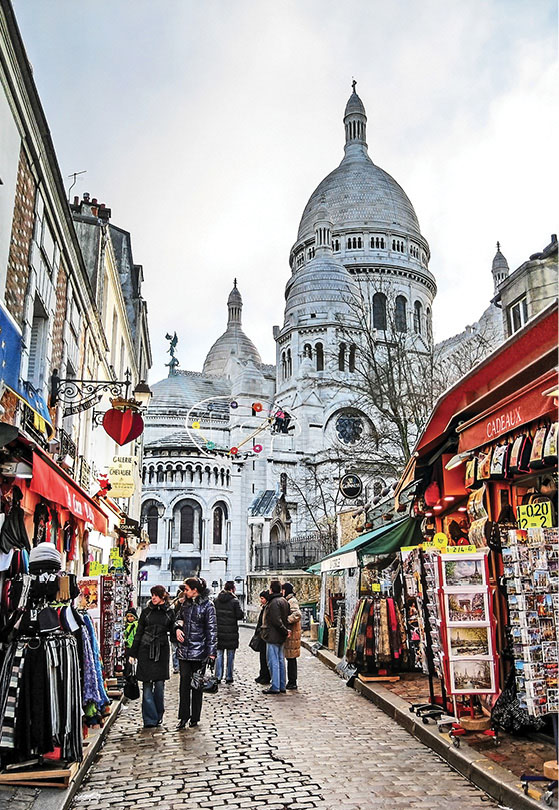
Iconic Sacré Coeur crowns the highest summit in Paris.
❾ Rue des Saules. Head down Rue des Saules, pausing to admire the oft-photographed cabaret Au Lapin Agile (www.au-lapin-agile.com), which was a favorite hangout of Picasso’s back when it was called Cabaret des Assassins. It’s still usually crowded with tourists, strange fans of old French music, and those seeking Picasso’s muse. Opposite, notice the small patch of vines, a throwback from the days when Montmartre was a wine-growing village separate from Paris. The Clos Montmartre harvest (red wine) is celebrated annually in October over a very boozy weekend.
❿ ★★ Cimetière de Montmartre. Retrace your steps and follow Rue Lepic back down past no. 54, where van Gogh lived with his brother Theo. Turn right onto Rue Joseph-de-Maistre and then left onto Rue Caulaincourt to this quiet resting place. Get a map from the gatehouse—it will help you find the graves of Truffaut, Stendhal, Degas, and many others. But don’t follow it too closely—it doesn’t list most of the graceful statues of exquisitely tragic women draped across tombs, nor does it tell you where the most beautiful trees stand, or where the light dapples through just so. You’ll have to discover those treasures on your own.  1 hr. Access on Rue Rachel by stairs from Rue Caulaincourt, 18th. ☎ 01-53-42-36-30. Free admission. Mon–Sat 8am–6pm, Sun 9am–6pm (Mar 16–Nov 5 until 5:30pm). Métro: Blanche.
1 hr. Access on Rue Rachel by stairs from Rue Caulaincourt, 18th. ☎ 01-53-42-36-30. Free admission. Mon–Sat 8am–6pm, Sun 9am–6pm (Mar 16–Nov 5 until 5:30pm). Métro: Blanche.
Montmartre Cemetery provides a peaceful respite from the neighborhood’s bustling streets and squares.
⓫ Moulin Rouge. Immortalized by Toulouse-Lautrec (and more recently, Nicole Kidman), this bright red windmill hasn’t changed much with time. Just as the windmill remains outside, the cancan still goes on inside. It’s all just as tawdry and tacky as it was when Toulouse-Lautrec downed one absinthe after another to endure it, but it’s still the most traditional place to see real cancan in Paris. See p 129.
This tour will take you past legacies of early-20th-century industrialized Paris—its tree-lined piers, iron footbridges, old factories, and warehouses—relics that evoke the days when Edith Piaf lifted the spirits of the nation with her soulful “La Vie en Rose” (1946). Today, this area, both scruffy and cosmopolitan, is one of the city’s most happening districts. Its bohemian vibe and new canal-side galleries and cafes make it a fun place to stroll. In summer, the Parc de la Villette—with its science and music museums, IMAX cinema, and open-air film festival—is a hip place to hang out. START: Métro to République.
❶ ★ Canal Saint-Martin. Walk across Place de la République to Rue Beaurepaire, lined with trendy shops and cafes. At the end of the street, you’re on Quai de Valmy. The Canal Saint-Martin, built between 1805 and 1825, begins at Bastille but hides underground until it gets to Boulevard Richard Lenoir. This is the prettiest stretch, lined with chestnut trees and iron footbridges that beg to be photographed. If you saw the film Amélie, you might recognize the canal from the stone-skimming scene.
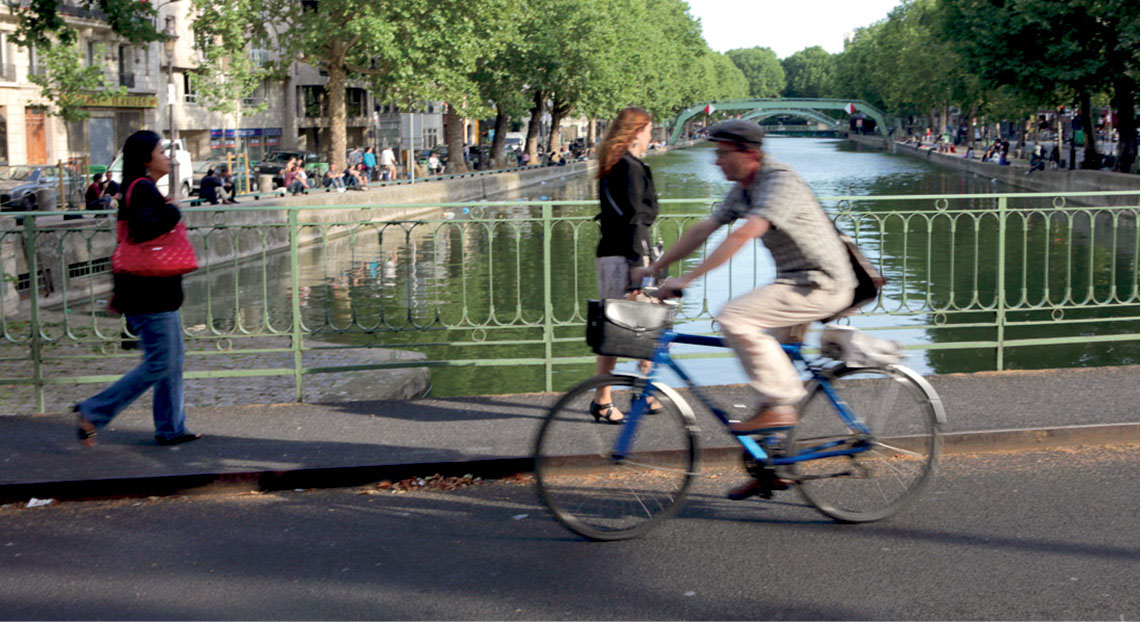
An iron footbridge on the Canal Saint-Martin.
Opposite Rue Beaurepaire, cross the footbridge and go up Avenue Richerand.
❷ Hôpital Saint-Louis. The Saint-Louis hospital was founded by Henri IV to house plague victims away from the city center and was built in the same style as Place des Vosges (p 63). Enter and then leave via the left wing, past the chapel. Av. Claude-Vellefaux.
Turn left onto Rue de la Grange aux Belles and note the spot where the Montfauchon gibbet (or gallows) once stood. Erected in 1233 and used for nearly 400 years, the macabre structure served as a place to execute criminals and display their hanging corpses. Then, turn right onto Quai de Jemmapes.
 L’Hôtel du Nord. Director Marcel Carné’s 1938 film Hôtel du Nord made this building (which still has its original facade) famous. Today, it’s a bistro serving hearty French cuisine with a typical 1930s interior—a fine choice for lunch. 102 quai de Jemmapes, 10th. ☎ 01-40-40-78-78. www.hoteldunord.org. $$.
L’Hôtel du Nord. Director Marcel Carné’s 1938 film Hôtel du Nord made this building (which still has its original facade) famous. Today, it’s a bistro serving hearty French cuisine with a typical 1930s interior—a fine choice for lunch. 102 quai de Jemmapes, 10th. ☎ 01-40-40-78-78. www.hoteldunord.org. $$.
Cross back over the Canal onto Quai de Valmy.
❹ ★ Quai de Valmy shops. New boutiques keep appearing along this stretch of the canal (and its adjacent streets). The best ones are Artazart, on Quai de Valmy (no. 83; ☎ 01-40-40-24-00), a cutting-edge bookshop stocking glossy art and design publications. Farther up, at no. 95, you’ll find kitsch clothes and collectables by Antoine & Lili (☎ 01-40-37-41-55). On Rue de Lancry, don’t miss Chez Chiffons (no. 47; ☎ 06-72-28-91-14), the latest hot spot for affordable ladies’ vintage designer apparel; and at no. 2 rue de Marseille, Centre Commercial (☎ 01-42-02-26-08) stocks funky clothes and accessories by up-and-coming French designers.
❺ Bassin de la Villette. At the top of the Canal Saint-Martin, you reach the circular Barrière de la Villette, one of the few remaining 18th-century tollhouses designed by Nicolas Ledoux (now a lively cafe). The modernist fountains in front channel your view up the Canal de l’Ourcq past the twin MK2 cinema complex. If you’re a film buff, spend a few moments in the MK2’s specialized bookshop (Quai de la Loire, 19th). If you fancy a film in English, look out for VO (version originale) written next to the title (providing it’s an English-language film, of course!).
Walk northward along the Canal de l’Ourcq.
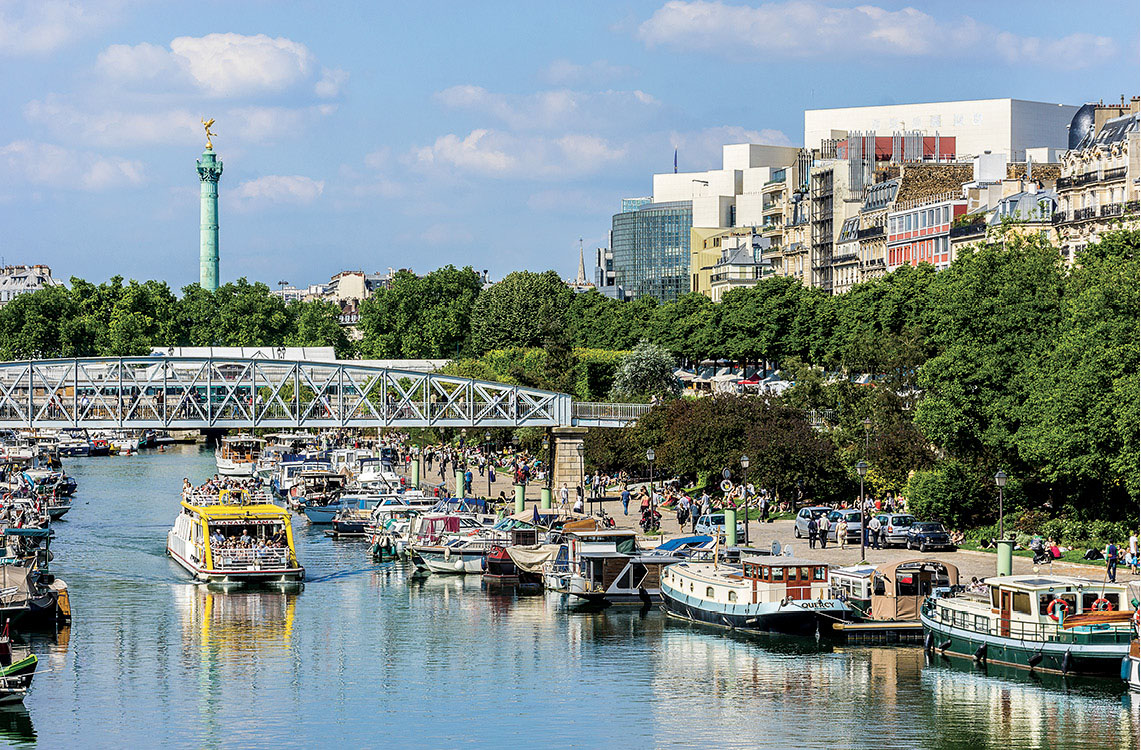
Houseboats docked on Canal Saint Martin.
 Bar Ourcq. Cheap drinks make this a popular bar with residents, especially on a hot day, when boules can be hired at the bar for a game of pétanque on the sand in front of the door. Be daring and challenge a local to a game (opens 3pm). 68 quai de la Loire, 19th. ☎ 01-42-40-12-26. $.
Bar Ourcq. Cheap drinks make this a popular bar with residents, especially on a hot day, when boules can be hired at the bar for a game of pétanque on the sand in front of the door. Be daring and challenge a local to a game (opens 3pm). 68 quai de la Loire, 19th. ☎ 01-42-40-12-26. $.
❼ Canal de l’Ourcq. Created in 1813 by Napoleon to provide drinking water and an additional route for transporting goods, this stretch is now characterized by 1960s and ’70s tower blocks. It is separated from the Bassin de la Villette by an unusual 1885 hydraulic lifting bridge.
❽  ★★★ Parc de la Villette. The city’s former abattoir district is now a vast retro-futurist park with wide-open lawns and play areas for children. On site is also the excellent Cité des Sciences museum (☎ 01-40-05-70-00; www.cite-sciences.fr), with a section entirely dedicated to kids (Cité des Enfants); the Philharmonie de Paris music museum and concert hall (☎ 01-44-84-44-84; www.philharmoniedeparis.fr; p 133); the Zenith concert hall (www.le-zenith.com), where international bands play; and the Geode 3-D IMAX movie theater, whose silver dome sparkles in the sunlight. In August, the park becomes an outdoor cinema (cinéma en plein-air) with Europe’s biggest inflatable screen. Av. Corentin-Cariou, 19th. ☎ 01-40-03-75-75. www.villette.com. Métro: Porte de la Villette or Porte de Pantin.
★★★ Parc de la Villette. The city’s former abattoir district is now a vast retro-futurist park with wide-open lawns and play areas for children. On site is also the excellent Cité des Sciences museum (☎ 01-40-05-70-00; www.cite-sciences.fr), with a section entirely dedicated to kids (Cité des Enfants); the Philharmonie de Paris music museum and concert hall (☎ 01-44-84-44-84; www.philharmoniedeparis.fr; p 133); the Zenith concert hall (www.le-zenith.com), where international bands play; and the Geode 3-D IMAX movie theater, whose silver dome sparkles in the sunlight. In August, the park becomes an outdoor cinema (cinéma en plein-air) with Europe’s biggest inflatable screen. Av. Corentin-Cariou, 19th. ☎ 01-40-03-75-75. www.villette.com. Métro: Porte de la Villette or Porte de Pantin.
When Montmartre artists did their jobs so well that the neighborhood became popular and rents went up, they all moved to Montparnasse. Before long, Picasso, Léger, and Chagall had joined Man Ray, Henry Miller, and Gertrude Stein on its somewhat forbidding streets. In terms of beauty, the two areas don’t compare—concrete is abundant in Montparnasse, but it offers plenty of sights to keep you busy. START: Métro to Montparnasse-Bienvenue.
❶  ★ Tour Montparnasse. Completed in 1973 and rising 210m (689 ft.) above the skyline, Paris’s most famous inner-city skyscraper was denounced by some as “bringing Manhattan to Paris.” The city soon outlawed any further structures of this size in the heart of the city. Today, it is frequented for its panoramic viewing platform on the 56th floor. Take in the skyline before splurging on a cocktail or dinner in the touristy Ciel de Paris restaurant (☎ 01-40-64-77-64), famed for its views. 33 av. de Maine, 15th. ☎ 01-45-38-52-56. www.tourmontparnasse56.com. Admission 15€ adults, 12€ ages 16–20, 9.20€ ages 7–15, free for children 6 & under. Apr–Sept daily 9:30am–11:30pm; Oct–Mar Sun–Thurs 9:30am–10:30pm, Fri–Sat & eve of public holidays 9:30am–11pm. Last lift 30 min. before closing. Métro: Montparnasse-Bienvenüe.
★ Tour Montparnasse. Completed in 1973 and rising 210m (689 ft.) above the skyline, Paris’s most famous inner-city skyscraper was denounced by some as “bringing Manhattan to Paris.” The city soon outlawed any further structures of this size in the heart of the city. Today, it is frequented for its panoramic viewing platform on the 56th floor. Take in the skyline before splurging on a cocktail or dinner in the touristy Ciel de Paris restaurant (☎ 01-40-64-77-64), famed for its views. 33 av. de Maine, 15th. ☎ 01-45-38-52-56. www.tourmontparnasse56.com. Admission 15€ adults, 12€ ages 16–20, 9.20€ ages 7–15, free for children 6 & under. Apr–Sept daily 9:30am–11:30pm; Oct–Mar Sun–Thurs 9:30am–10:30pm, Fri–Sat & eve of public holidays 9:30am–11pm. Last lift 30 min. before closing. Métro: Montparnasse-Bienvenüe.
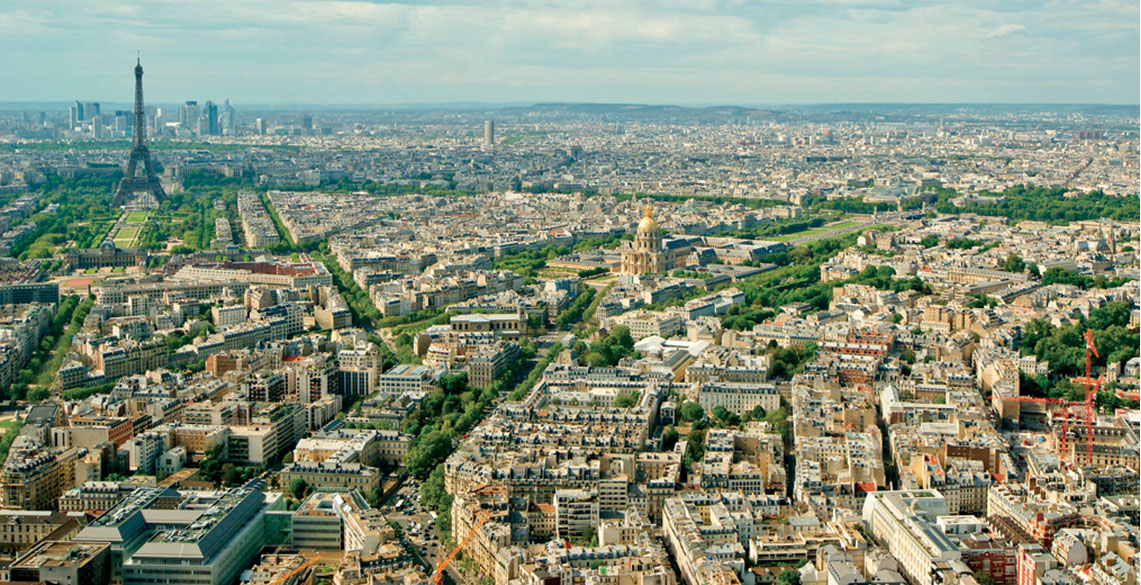
The view from the 56th floor of the Tour Montparnasse.
❷ Mémorial du Maréchal Leclerc/Musée Jean Moulin. This rooftop museum fills you in on World War II France and the French Resistance. The absorbing film archives and the art—which includes posters exhorting residents of occupied France to work in Germany—show what the French endured.  1 hr. 23 allée de la 2e DB Jardin Atlantique (above Grandes Lignes of Gare Montparnasse), 15th. ☎ 01-40-64-39-44. www.ml-leclerc-moulin.paris.fr. Admission free for permanent collection. Exhibitions: 5€ adults, 2.50€ ages 14–26, free for children 13 & under. Tues–Sun 10am–6pm. Métro: Montparnasse-Bienvenüe.
1 hr. 23 allée de la 2e DB Jardin Atlantique (above Grandes Lignes of Gare Montparnasse), 15th. ☎ 01-40-64-39-44. www.ml-leclerc-moulin.paris.fr. Admission free for permanent collection. Exhibitions: 5€ adults, 2.50€ ages 14–26, free for children 13 & under. Tues–Sun 10am–6pm. Métro: Montparnasse-Bienvenüe.
❸ Musée Bourdelle. Surrounded by pretty gardens, this museum is where French sculptor Antoine Bourdelle (1861–1929) worked. It was here that he pioneered 20th-century monumental sculpture, and you can’t help but feel dwarfed by the sheer size of his masterpieces, which—as you walk through his atmospheric old atelier and gardens—each tell their own mythical story. Bourdelle is buried in the Cimetière de Montparnasse, stop ❺ of this tour.
 Boulevard du Montparnasse. Just a block from the train station, this well-traveled street gets busiest at night, when its brasseries and cinemas are aglow, but at any time of day the enticing aromas may lure you to one of its many creperies or brasseries. Succumb to a full meal at no.108, Le Dôme, now a seafood restaurant ($$); or at no.102, La Coupole, a fabulous Art Deco brasserie ($$). A bit farther along, at no. 171, La Closerie des Lilas, includes among its former fans an unlikely combination of Picasso, Trotsky, Lenin, and Hemingway ($$$).
Boulevard du Montparnasse. Just a block from the train station, this well-traveled street gets busiest at night, when its brasseries and cinemas are aglow, but at any time of day the enticing aromas may lure you to one of its many creperies or brasseries. Succumb to a full meal at no.108, Le Dôme, now a seafood restaurant ($$); or at no.102, La Coupole, a fabulous Art Deco brasserie ($$). A bit farther along, at no. 171, La Closerie des Lilas, includes among its former fans an unlikely combination of Picasso, Trotsky, Lenin, and Hemingway ($$$).
❺ ★ Cimetière du Montparnasse. A short walk down Boulevard Edgar-Quinet, past its many attractive cafes, takes you to this well-known burial ground. For literary and philosophical types, it’s a must-see, with the graves of Samuel Beckett, Charles Baudelaire, and Man Ray, as well as the shared grave of Simone de Beauvoir and Jean-Paul Sartre, usually covered in tiny notes of intellectual affection from fans. 3 bd. Edgar-Quinet, 14th. ☎ 01-44-10-86-50. There’s a map posted to the left of the main gate. Free admission. Mon–Fri 8am–6pm, Sat 8:30am–6pm, Sun 9am–6pm. Métro: Edgar Quinet.
❻ ★★  Les Catacombes. Just before the Revolution, Paris’s cemeteries were bursting at the seams, spreading disease. To solve the problem, millions of bones were transferred underground into the quarried tunnels that sprawl beneath the Denfert-Rochereau district. These catacombs, 18m (60 ft.) underground, can be visited today. It feels incredibly strange seeing miles of neatly stacked bones and skulls, and it’s surprisingly rather moving. The sign at the appropriately eerie entrance reads “stop! this is the empire of death!” Older kids will love it; younger ones will probably have nightmares.
Les Catacombes. Just before the Revolution, Paris’s cemeteries were bursting at the seams, spreading disease. To solve the problem, millions of bones were transferred underground into the quarried tunnels that sprawl beneath the Denfert-Rochereau district. These catacombs, 18m (60 ft.) underground, can be visited today. It feels incredibly strange seeing miles of neatly stacked bones and skulls, and it’s surprisingly rather moving. The sign at the appropriately eerie entrance reads “stop! this is the empire of death!” Older kids will love it; younger ones will probably have nightmares.  1 hr. 1 avenue du Colonel Henri Roi-Tanguy, 14th. ☎ 01-43-22-47-63. www.catacombes.paris.fr. Admission 10€ ages 27 & older, 18€ ages 18–26, free for children 17 & under. Tues–Sun 10am–8pm (last ticket sold at 6.45pm). Métro/RER B: Denfert-Rochereau.
1 hr. 1 avenue du Colonel Henri Roi-Tanguy, 14th. ☎ 01-43-22-47-63. www.catacombes.paris.fr. Admission 10€ ages 27 & older, 18€ ages 18–26, free for children 17 & under. Tues–Sun 10am–8pm (last ticket sold at 6.45pm). Métro/RER B: Denfert-Rochereau. 
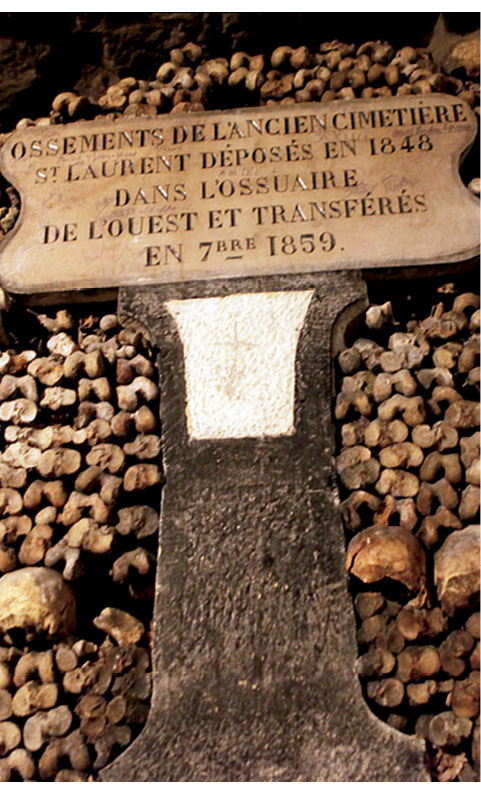
Six million skeletons stretch 910m (2,986 ft.) through underground tunnels in Les Catacombes beneath Paris.